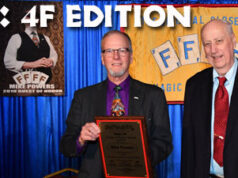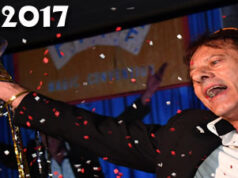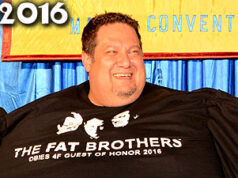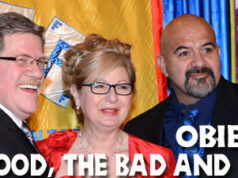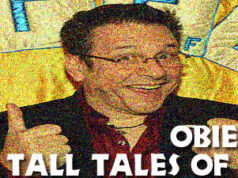Reported by Robin Dawes • Photographed by Dale Farris
Konnichiwa. It may have occurred to you, dear reader, that a good magic gathering can be like a classical Japanese garden: filled with mystery, delight and unexpected pleasures. Japanese gardens are all about concealing and revealing, balance, naturalness, achieving the maximum effect with the minimum overhead, and transporting the visitor to a different state of mind – all of which sound remarkably like the ideal features of close-up magic.
On April 25, in Batavia NY, a metaphorical garden gate opened and 200 plus close-up magicians from around the world entered in to the 37th annual Fechter’s Finger Flicking Frolic (FFFF) – the original close-up convention, attendance by invitation only. This year’s Guest of Honor was the renowned Ton Onosaka.
The foundations of any Japanese garden are its rocks (ishi). Garden rocks are expected to set the tone for the entire arrangement. FFFF’s rocks are the half-dozen or so lectures that Head Forker Obie O’Brien arranges with the skill of a gardening master. More than anything else, the lectures define the scope and the depth of the convention. This year’s lecturers were outstanding, and we will encounter them individually as we stroll the garden’s path.
Vanni Bossi’s lecture opened the convention. Hepresented a material-packed session using coins, cards, bills, rings, light bulbs, credit cards, picture frames and more. An effect in which he used an empty glass to scoop a selected card from a spread deck was a particular highlight for many in the audience. He concluded with a solution to a problem of Hofzinser – having a signed selection appear rolled inside a finger ring held by the volunteer. This lecture was a very solid rock around which the rest of the convention could unfold.
Daryl’s lecture was filled with practical, attainable effects. He started with an effect in which he blindfolded himself with two jokers that transformed into two selected cards, continued with versions of 3-Fly, Matrix, and the Acrobatic Knot. One item that earned a very positive response was an updated handling of a classic and very easy method for the Rising Cards. His method for naming multiple thought-of selections was bold, clever, and completely deceptive. As a garden element, this lecture was an arching rock – full of wit and energy.
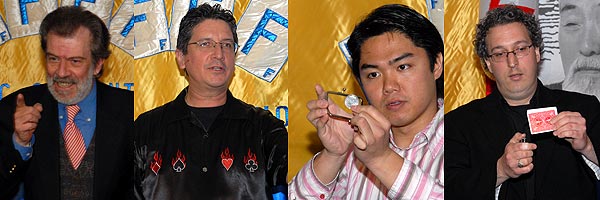
Lectures: Vanni Bossi, Daryl, Shoot Ogawa and David Acer.
In a Japanese garden as in close-up magic, naturalness is an ideal. Objects should appear as they do outside the confines of the garden. I think it is this that makes the two “open teaching” sessions (Roger Klause’s Teach-A-Trick and Pat page’s Workshop) particularly attractive for me. People share their workers – routines that they use in the real world. The routines are usually straightforward, practical, and strong.
In the Teach-a-Trick session, Roger Klause taught a false count that is particularly effective with currency – ideal for a short-change routine. Prof Rem (or was it his evil twin?) taught two origami folds with money: the first allowed a coin production from a folded bill, and the other reversed one half of a bill through the other half without ripping the bill into two pieces. Tom Craven taught a colourful effect using silks in glasses and the volunteer’s zodiac sign. Tony Econ taught his great Blazing Saddles card trick.
Another fundamental principle of Japanese gardening is the appropriate use of plants (shokobutsu). Unlike western gardens that focus on just the warm months, the plants in a Japanese garden are expected to present a range of visual delights throughout the year. So too at FFFF do the many shows offer a cornucopia of close-up magic, from the eye-candy that thrills and fades to the low-key impossibility that sits in the back of your mind for months, gaining in mystery every time you think of it.
Obie O’Brien was the MC for the Kick-Off Show. First up, Steve Duperré changed a 6 into a 9 – then shook all the pips on a card down to one end. Bill Spooner used a gambling theme to present the Atomic Aces. Yannick Lacroix performed elegant thimble manipulations to a jazz accompaniment. Rick Wilcox performed a rope routine then produced many many coins. Bill Wells performed two classic routines: Kaps’ sponge ball routine, and Ramsay’s cylinder and coins. John Luka presented a transposition routine with coloured balls, then some excellent card magic. Richard Kaufman showed the Gene Maze Ace production and the Phoenix Aces, using a technique he attributed to the great Jerry Andrus.
Sabi is a difficult Japanese term to translate, but in the garden it relates to things that have revealed their true essence through time. How fitting then that FFFF should feature a show titled Familiar Faces, with the always genial Mike Hilburger performing the MC duties. First, Karl Norman cut a square of paper to form two linked rings – a minor miracle presented with his trademark deadpan humour. Mike Stratman magically transported a set of crumpled paper balls from his hand to a box, to the accompaniment of an instrumental version of the Beatles’ “Yesterday”. Bill Abbott played the violin with great skill as selected cards rose gracefully from an isolated deck of cards. Miguel Gea performed a sequence of very magical coin routines. Fred Casto, the International President of the IBM, performed “two covers and four objects” with coins and napkins, then followed up with the tale of State Street Eddie. Tonny Van Rhee presented a magical history of coins and purses. Bebel (with Boris Wild translating) performed a stunning sequence of card transpositions involving a selected card and the four aces. Jim Klayder presented Larry Jennings’ version of Open Travellers with instant repeat. Glenn Brown performed a brisk linking rings routine. Yosuke Kobayashi exhibited his magical powers over coins. Adam Spigel transformed a stack of $1 bills into $100 bills. Christian Engblom magically pushed half a deck of cards through the table.

Ton Onosaka served as MC for a lecture that introduced magic from five outstanding Japanese magicians. Hiro Sakai taught a very clean bill penetration, a colour-changing card routine, an impromptu string and finger penetration, a Just Chance routine using balloons, a no-gaff version of Psi-Con-Ruse, and an excellent handing of the Rainbow Deck force that allows the forcing of any number of cards rather than the traditional two. Toto demonstrated and taught a multiple bill switch routine that dispensed with the usual gaff. Kazu Akayama shared a cut and restored hanky effect that boldly employed a sixth finger. Yosuke Kobayashi taught a funny card prediction effect in which a very long card is pulled from a small sealed envelope. Yuji Wada shared the work on an off-beat card routine in which the figure of a Jack escapes from its card, leaving a cut-out hole.This lecture was like a cluster of small stones set in a bed of sand, each stone unique and charming.
The second of the two open teaching events was the annual Pat Page Workshop: the theme this year was Magic at the Dinner Table. Pat Page led off with a coin vanish using a handkerchief. Patrice performed card fan productions (“This is how I always start my set at a table!”) then taught a funny but unfortunately not very practical method for finding a freely named card on the bottom of your shoe. Gene Gordon shared a multi-effect routine using plastic straws and wrappers. Ali Bongo also made magic with straws, in this case cutting and restoring them, and performing the soon-to-be-famous Six Straw Repeat. Pat Page returned to teach his Plate From Knee effect. Roger Bernheim showed his astonishing ability to balance a toothpick on the edge of glass (not as easy as you might think!) Mark Zacharia taught a card routine reminiscent of Oscar, but with restaurant names on the cards. David Corsaro shared a trick that was all about Tom Craven. This was a real worker that I expect will enter a lot of repertoires. David Neighbors, coin guru extraordinaire, taught a routine that used sugar packets but which may have been a coin routine in disguise. Bob Swadling shared his work on the Acrobatic Match Boxes. Kevin Gallagher was limited for time, so he did not teach what he had planned but instead gave us a brilliant impromptu method for penetrating a coin through the bottom of a glass. George Silverman taught the Card Under the Tablecloth, and explained that the most difficult part of the method is believing that you can do it. Keith Randolph taught us how to give a volunteer the magical power to magnetize spoons. Magic Christian closed the workshop with a cutlery bending routine incorporating a novel application for the technology behind the Fortune Telling Fish. As always this workshop was a highlight of the convention for me, with enough creative ideas to keep me going for a year. It was later decided that the theme for next year’s Workshop will be Quick Stunning Openers.
Japanese gardeners often take advantage of scenery outside the garden (shakkei), using clever framing to incorporate views of the outer world. In this spirit, Obie created the World Performers Show, with himself at the helm. Leading off, Rod Chow presented his award-winning Money act. This act has been in development for over 15 years. Camilo transformed some casino chips and demonstrated his dice-stacking prowess. Shoot Ogawa conjured with coins and cards and photographs. Simo Aalto performed his FISM winning act, performing a Cups and Balls routine with bells and jingling balls. Bob Swadling performed some of his unique card and coin magic. M. C. Chow did a red-themed act, using red disks for Matrix, red-faced cards, and glasses of red wine. Vanni Bossi found a selected card inside a cigarette lighter, and showed how difficult it is to count money correctly. Hayashi produced coins from nowhere and did a very sophisticated Matrix routine. Rick Merrill reprised his FISM winning act with coins and Sharpie markers.

Japanese gardeners also know the value of balance (sumi) and contrast (in and yo). At FFFF, this was embodied in the Friends Old and New Show, with MC Meir Yedid. Meir showed us how they make sushi in the Big Apple. Hull Youngblood presented an effect of galactic proportion by making a mentally selected card appear as the only normal card in a deck of blank cards. Edward Ripley performed a routine with huge coins, then a card trick in which the Joker kept popping up in unexpected places. Gordon Bean did the Existential 21 Card Trick. Mark Ross presented an Okito Box routine with Chinese coins, and a Monte effect using Tarot cards. Gene Protas predicted the result of volunteer’s calculation involving their address and Zip Code. John Bannon performed an ungaffed version of Twisted Sisters. Ryan Siebert performed an intriguing routine in which the name of a selected card was whispered around the room. When it reached its destination, the name of the card had changed, but Ryan was able to locate both the final card and the mis-relayed original. Luis Otero magically transported cards from one deck to another, and did an impressive four Ace routine in which the deck was finally restored to new-deck order. David Corsaro shuffled a deck face up and face down, after which all the cards turned face down except some that revealed a telephone number selected by a volunteer. Toto tried to use magic to bend a coin, but other things kept bending instead. He then caused several selected cards to animate in a variety of creative ways. Sammy P. Smith did an elegant silk production and magically caused a coin to penetrate a bottle. Steve Marshall introduced us to Elvis the Wonder Flea, then sang a song about FFFF, very reminiscent of Gilbert and Sullivan’s “Model Major General”. Richard Hatch spoke fluent Japanese, with Steve Marshall providing a very funny translation. Richard performed the Gypsy Thread effect. Curtis Kam balanced coins on a flashlight beam and performed the only card effect of the entire convention that involved a cowrie shell.
At the Friday Night Show, Obie was back at the mike as MC. Garrett Thomas performed the most talked-about act of the convention. He began with a reading from Black Elk, then performed a dramatic depiction of “The Magician’s Cycle” from birth to death and rebirth. John Born performed a poetic rendition of the Linking Rings, accompanied by the haunting music of Loreena McKennitt. Ali Bongo performed a very funny song of his own composition titled “Just a Little Touch of Magic”, then conjured with cards, newspaper, and rope. He concluded by pulling a small metal ring all the way over his head. Flip performed a rope routine infused with his droll humour. Richard Sanders performed with cards and with a borrowed bill, which eventually was found inside the cap of the marker used to sign it. Reed McClintock began his act with some wonderful contact juggling, continued with coin productions, then concluded with the most original razor-blades-in-mouth routine I have seen. David Acer found a selected card inside a wall-mounted smoke detector, then demonstrated How Not to Perform Glorpy. David Regal told us of his lifetime experience with the Cups and Balls as he performed, and ended with final loads that perfectly fit his story. Kevin Gallagher performed a baffling sequence of card transpositions with a borrowed deck and concluded with Oil and Water, performed first with cards and then with coins. Geno Mozzarella (aka Danny Archer) showed us how a hat and some dice can lead to magical trouble in East Philly. Raymond Iong conjured with coloured disks that transposed and finally composed into a portrait. Boris Wild concluded the show with “10 Ways to Know You are a Magician” and “Top 5 Over-used Pieces of Music in Magic Shows” – both lists were hilariously accurate.
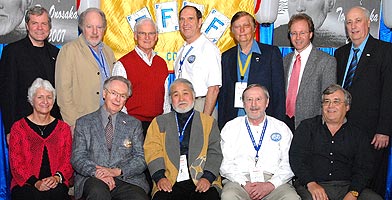
Adding another rock to the garden’s layout, Shoot Ogawa presented a lecture in which he began with the basic thimble sleights, then demonstrated how to structure them into a visually effective routine that includes productions, vanishes and colour changes. He also taught techniques for the Linking Rings, bare-hand coin vanishes, purse frame magic, a brilliant version of Triumph that ends with the cards in new-deck order, and a rope routine from Tabary. For me, the most valuable lessons taught throughout this lecture were the observations about framing the effect, and changing the moment. As a garden element this was a mysterious rock, deserving of contemplation from different directions.
The final lecture of the convention was presented by David Acer. Hegave us a multi-person lecture, in which David taught some of his own excellent routines and also drew upon the talents of several other Canadian magicians. David taught a card-splitting routine, three effects with a borrowed ring (including linking it to a borrowed pair of eyeglasses), a cell-phone production from a folded envelope, and a card reversal effect. Yannick Lacroix showed an application of the Muscle Pass to render an invisible coin visible. Michel Huot used a cell-phone camera to make a selected card materialize in a photograph. Bill Abbott taught a repeat Mullica Wallet routine that also includes a torn-and-restored phase. Richard Sanders shared the secret of the Bill in Marker Cap routine that he had performed earlier in the convention. Patrice explained his “Signature Piece” in which three pieces of printed text materialise one by one on the back of a signed selection.
The Saturday Afternoon Show featured Dan Garrett as MC. The show started with an amusing video titled “Magic Through the Eyes of a Dove”. Brian Roberts performed with coins in a tribute to “What I Love” – with a very funny finish. Ricky Smith performed a hilarious routine about the sadness inherent in losing a card. Eric Leclerc appeared as a psychological patient with frequent needs to top up his medication. Roger Benoit filled a table with bottles that kept multiplying, as the contents took greater and greater effect upon him. Bill Butski proved that the trained mind is more powerful than an electronic calculator. Albert Tam performed unique magic with a die and a mirror. Matthew Episcopo magically arranged one set of cards into exactly the same order as another shuffled set. Dick Stoner performed the Rising Cards: two cards rose under their own power, but the third needed the help of a large blue pill. Kazu Katayama drew a sketch of Obie, then folded it in such a way that the reduced image identified a selected card. Kainoa Harbottle performed coin magic and the Linking Rings, with a particularly graceful sweeping link and unlink that was new to many in the audience. Jomaguy told a tale of trying to cheat at a dice game but being caught due to the sudden appearance of different coloured dice. Dani DaOrtiz did superb versions of Wild Card and Oil and Water, then won a lot of laughs with a good-hearted impersonation of Lennart Green.
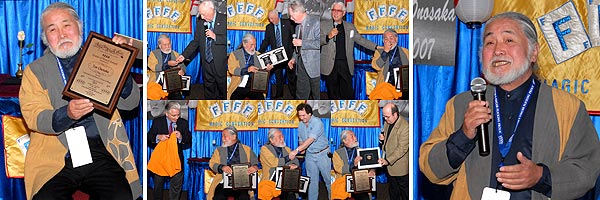
For the Grand Finale Saturday Night Show, Obie O’Brien resumed the MC duties. As usual, the show commenced with a tribute to the Guest of Honor. Ton Onosaka received presentations from Obie O’Brien, Phil Wilmarth, Paul Gertner, Marv Leventhal, Richard Kaufman, Roger Klause, and Vic Trabucco. Performances began with Marc Oberon, whose act was themed around objects turning to gold. Daryl borrowed a deck of cards, had several people shuffle them, and then was able to cut to the Aces with his eyes closed. He concluded by transforming two signed selections into impossible objects. Jim Molinari performed a very clean rendition of Follow the Leaders. Paul Gertner had a volunteer think of one card getting burned, then revealed that that was the only charred card in the deck. Paul presented a poem about the questions that audiences ask magicians. Howie Schwarzman performed coin magic, a card penetration, and the rarely seen R. B. Stubs routine. Rocco performed as only he can, with a seemingly effortless sequence of productions and transformations of unlikely objects. Smoke, wine, grapes, eggs, ice cream, corn, limes, a razor, a pipe, cigarettes, ice, lemon juice … the list goes on and on.

After a short intermission, Obie announced that next year’s FFFF Guest of Honor will be Boris Wild. Kicking off the second half of the show, David Jade took the stage with an astonishingly visual transformation of three random cards into Aces. Mark Mitton performed his trademark sushi mat routine. Mike Robinson brought his little friend Terrence and together they “vented” their feelings about Obie and others. Hiro Sakai borrowed a ring and sealed it in a purse. With a flash of fire, the ring appeared locked in a padlock – the key to which was found in the purse. Steve Bargatze closed the show with the Straitjacket of Death.
As always, the convention ended with the announcement of the recipient of the Lou Gallo MVP Award – this year’s honouree is Shoot Ogawa.
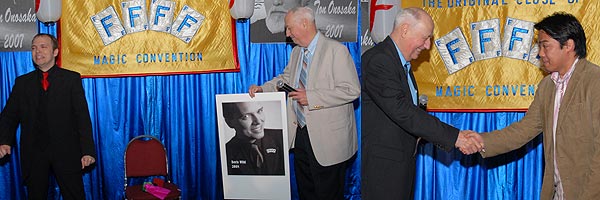
Obie O’Brien announcing Boris Wild as the 2008 Guest Of Honor and congratulating Shoot Ogawa for being named the 2007 MVP.
Alas, all good things must end. Too soon, the convention ended, the garden gate opened, and 200 magicians dispersed again to the four corners of the globe – each, it is to be hoped, carrying a gem of enlightenment. Sayonara.


